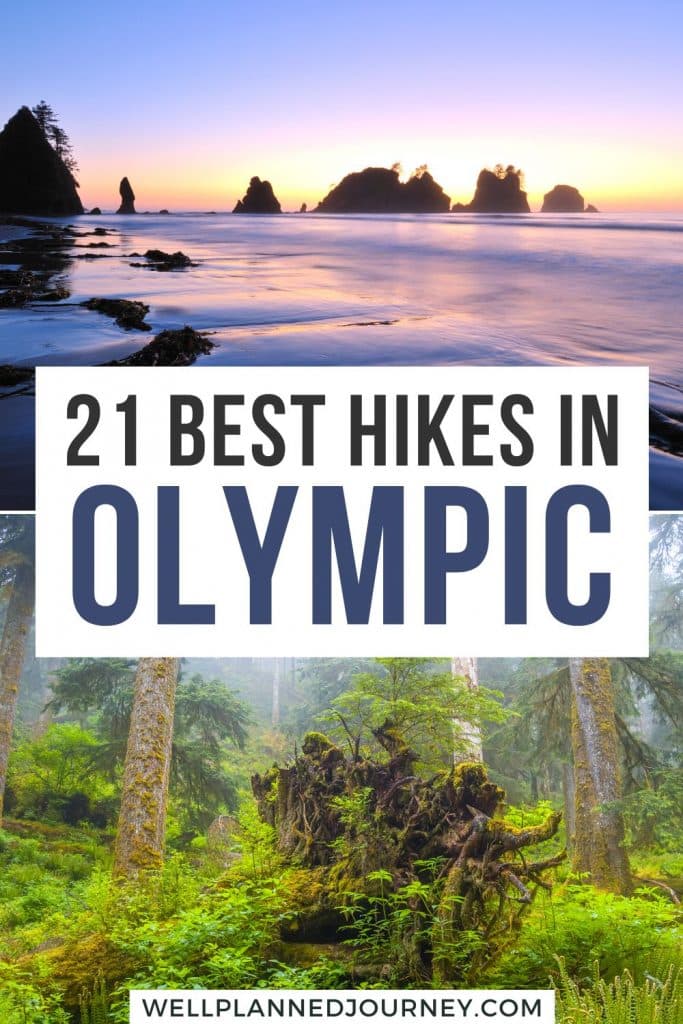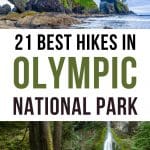Rugged coastline. Majestic alpine landscapes. Dense temperate rainforests. Olympic National Park is home to some of the world’s most unique landscapes, all within 1,500 square miles.
But with nearly 200 hikes across vastly different landscapes, how do you decide what to add to your Olympic National Park itinerary?
That’s where this guide comes in!
In this post, you’ll find all the details on the 21 best Olympic National Park hikes, including everything from easy hikes through rainforests to challenging summit trails and multi-day backpacking trips.
Plus, I’m sharing need-to-know tips for hiking in Olympic National Park, including an overview of the unique park landscapes, how to get there, and the best time to hike in Olympic.
This post may contain affiliate links, where I may receive a small commission at no additional cost to you. Read more in this disclosure policy.
Olympic National Park At-A-Glance
Before diving in, here are a few highlights to help you plan your trip:
- Best Time to Visit: July to September is the best time to visit when all roads are open and rain is minimal. Higher elevation areas like Hurricane Ridge are typically only open from mid-June to October.
- Where to Stay: The most conveniently located lodges in Olympic National Park are Lake Crescent Lodge and Kalaloch Lodge. If you want to stay outside the park, consider staying at the Olympic Lodge or the Woodlands Inn.
- How to Get There: The closest airport is in Seattle, 2 to 3 hours away. Use Expedia to browse flights and find the best price.
- How to Get Around: My favorite way to see Washington is by campervan. I had a fantastic experience renting a luxury campervan through Noma Vans on Outdoorsy. You can also easily get around by car. I recommend using Expedia to browse for deals.
- Don’t Forget: Be sure to get an America the Beautiful National Park Pass ahead of time. This $80 pass is valid for 12 months and gets you into all 400+ national park sites (including all 3 Washington parks).
Overview of the Regions of Olympic National Park
Olympic National Park is located in northwestern Washington state on the Olympic Peninsula. The peninsula is directly west of Seattle, separated by water, a few islands, and smaller peninsulas.
The Olympic Peninsula is home to several unique landscapes within a close geographic area. Here you’ll find everything from coastline to alpine to temperate rainforests.
With so much diversity, many hiking options have dramatically different views.
This blog post splits the best hikes in Olympic National Park by region, allowing you to pick the best hikes from each landscape.
While there are several distinct biomes, the significant sections of the park covered in this guide are:
- Hurricane Ridge is the heart of Olympic’s alpine region, located at around 6,800 feet. You’ll find hikes with panoramic mountain views and opportunities to spot Roosevelt elk and marmots.
- Crescent Lake is the closest park region to Seattle, perfect for day trips. The hikes surrounding this glacially carved lake offer everything from rainforests to mountain peaks to waterfalls.
- The Pacific Coast is one of the most expansive areas of Olympic National Park, spanning more than 60 miles. These coastal hikes offer incredible opportunities for catching the sunset and exploring the rough, rocky shorelines.
- Hoh & Quinault Rainforests are two of the park’s more popular temperate rainforest regions. While both offer incredible mossy, tree-filled forests, Hoh Rainforest is more popular thanks to its central location. So instead, Quinault Rainforest provides a nice break from crowds.
- The Staircase is the least visited area of Olympic National Park, located on the southeastern side of the Peninsula. This rugged, less developed region offers beautiful mountainous hikes and quiet strolls along scenic rivers.

How to Get to the Olympic National Park Hikes
Seattle is the closest major city to Olympic National Park, about 2 to 3 hours away. However, due to the water separating the peninsula from Seattle, there are only two great ways to reach the park:
- Take the ferry. There are several options from Seattle to the Olympic Peninsula. However, the Bainbridge Island Ferry or Kingston Fast Ferry are the most popular options. The ferry is slightly faster and saves gas and car mileage, but it is more expensive.
- Drive around the peninsula. The other option is driving around Puget Sound and up the peninsula. Driving is the best option if you’re visiting the coastal or southern regions of the park.
Read More: 3 Best National Parks in Washington
Best Time to Visit Olympic National Park for Hiking
Unlike Washington’s other national parks, Olympic National Park can be visited and enjoyed year-round thanks to its diverse park climates. However, particular areas close in the winter months, and the weather can vary by season.
Overall, the best time to visit Olympic National Park is in the summer, when temperatures are warm, there is minimal rain, and all park areas are open.
Here’s what to expect when visiting Olympic National Park each season:
- Spring – Like many areas, Spring has cooler and milder temperatures and more unpredictable weather. Spring also brings rainy weather to the rainforests, averaging 10 inches of rain per month. Higher elevations, like Hurricane Ridge, are still closed this time of year as snow continues to fall until June.
- Summer – This is the driest and sunniest time, perfect for hiking. However, it’s popular so expect crowded trails in Hoh Rainforest and Hurricane Ridge. Temperatures vary by region, with higher elevations remaining cooler. Hurricane Ridge Road typically opens in early June.
- Fall – Temperatures begin to drop by mid-September, and rainfall picks up again in October. Early September after Labor Day can be an excellent time to visit to avoid summer crowds but still enjoy warmer hiking weather. Road closures at higher elevations usually start in October.
- Winter – This is the coldest and least visited time of year, with many areas covered in snow or soaked in the rain. Higher elevations stay below freezing, with lower elevation beaches and rainforests in the 40s or 50s. Hoh Rainforest averages nearly 20 inches of rain per month. You’re rewarded with crowd-free hiking trails if you can brave the conditions.
Are you visiting multiple national parks in the next year? The America the Beautiful National Park Pass gets you into 400+ national park sites, including all 63 national parks, for 12 months!
Get your national park pass ahead of time for only $80.
Best Hurricane Ridge Hikes
This alpine region is one of my favorite areas in Olympic National Park.
Characterized by the towering Olympic mountain range, trails here provide incredible panoramic views of the alpine region and opportunities to spot wildlife like elk and marmots.
It’s important to note that Hurricane Ridge trails are best hiked in the summer, from late June until September. Hurricane Ridge Road is closed most of the winter, and the trails are not cleared of snow until June.
1. Hurricane Hill via Hurricane Ridge Trail
- Distance: 3.4 miles
- Elevation Gain: 826 feet
- Difficulty: Moderate
- Time to Hike: 1 to 2 hours
- Trailhead: Hurricane Hill Trailhead
- Read reviews on AllTrails

Hurricane Hill is easily one of the best hikes in Olympic National Park, particularly for lovers of the mountains. The trail starts at the end of Hurricane Ridge Road, a few miles past the visitor center.
The elevation is moderate on a wide, maintained trail up to a panoramic vista, making this an excellent family-friendly hike.
Along the way, you’re rewarded with incredible views of the tallest peaks in Olympic National Park. From the final vista, you can see as far as Mount Baker and Vancouver Island in Canada on a clear day!
2. Mount Angeles via Klahhane Ridge Trail
- Distance: 5.5 miles
- Elevation Gain: 2,017 feet
- Difficulty: Hard
- Time to Hike: 4 to 5 hours
- Trailhead: Hurricane Ridge Ski Area
- Read reviews on AllTrails
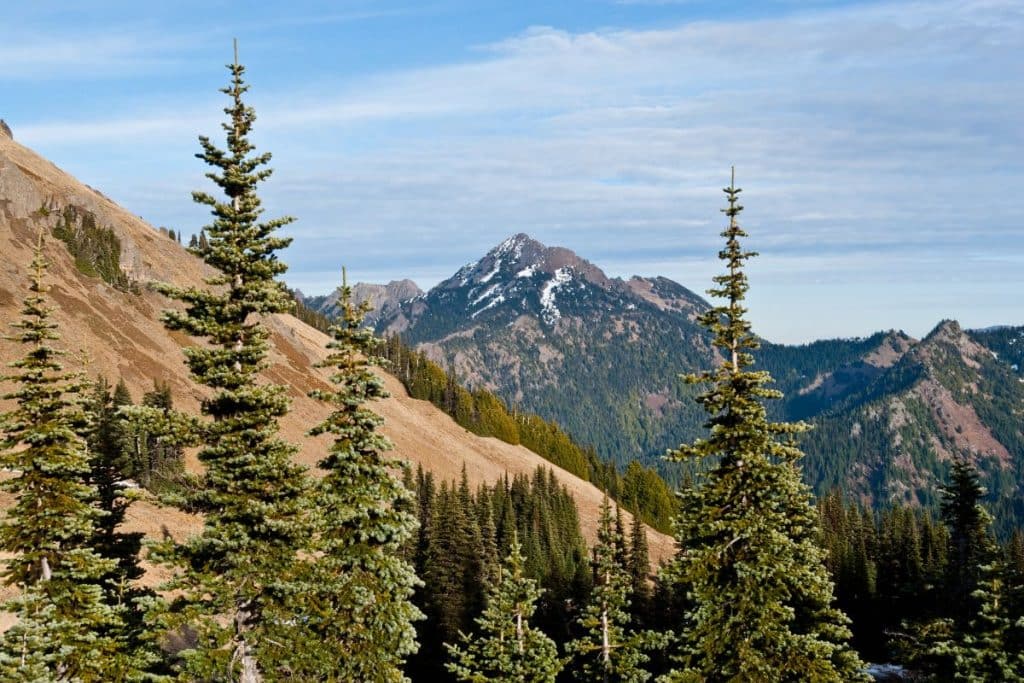
If you’re looking for a challenging, great hike with mountain views, don’t miss the hike to Mount Angeles along the Klahhane Ridge Trail!
The trail starts near the Hurricane Ridge Visitor Center and initially follows the High Ridge Nature Trail.
Then, after a quick detour to Sunrise View Point, the hike continues along the ridgeline, climbing to Mount Angeles, the highest peak in the Hurricane Ridge area!
The trail to the top of Mount Angeles is an unmaintained Class 3 scramble and should only be done by experienced hikers with climbing equipment.
If you’re not up for the climb, turn around at the base of Mount Angeles instead. The Klahhane Ridge Trail still has incredible views even if you don’t reach the summit!
3. Klahhane Ridge Trail to Lake Angeles
- Distance: 12.6 miles
- Elevation Gain: 4,514 feet
- Difficulty: Hard
- Time to Hike: 9 to 10 hours
- Trailhead: Hurricane Ridge Ski Area
- Read reviews on AllTrails

The Klahhane Ridge Trail to Lake Angeles is one of the longer day hikes on this list of the best hikes in Olympic. Like other Hurricane Ridge trails, it provides excellent views of the alpine region and its wildlife.
The trail follows the same route as the hike to Mount Angeles above, starting near the Hurricane Ridge Visitor Center. When you reach the base of Mount Angeles, you’ll continue onward to Lake Angeles instead.
Following a steep ascent on switchbacks through a wooded area, you’ll catch your first view of this picturesque alpine lake from above before continuing to the lakeshore.
This hike is covered in wildflowers and wildlife like mountain goats, deer, and marmots in the summer!
Are you planning a national park trip but don’t know where to start? Get my free 28-page national park ebook where I break down everything you need to know to visit all 63 USA national parks.
Download your free ebook here.
Best Hikes Near Crescent Lake
This area is one of the most easily accessible parts of Olympic National Park for those coming from Seattle. The region gets its name from the large glacial lake about 18 miles west of Port Angeles.
Hikes in Crescent Lake are a mix of temperate rainforests, stunning mountain peaks, and lush waterfalls. So, if you want to experience variety and greenery in Olympic National Park, don’t miss hiking in the Crescent Lake area!
4. Sol Duc Falls Nature Trail
- Distance: 1.6 miles
- Elevation Gain: 226 feet
- Difficulty: Easy
- Time to Hike: 45 minutes
- Trailhead: Sol Duc Trailhead
- Read reviews on AllTrails
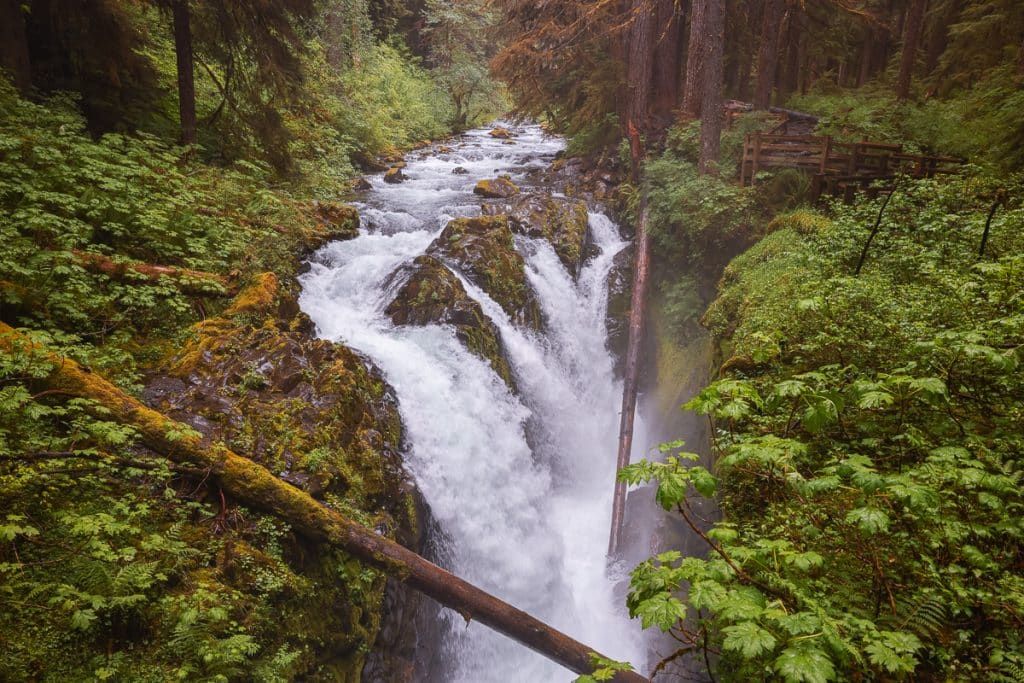
If you want to see incredible waterfalls and lush rainforests, don’t miss the Sol Duc Falls Trail! This hike is one of the most popular hikes in the Lake Crescent area, located only a few miles away from the famed Sol Duc Hot Springs Resort.
The trail starts at the end of Sol Duc Hot Springs Road and follows an easy path with mild elevation out to the waterfall.
Before reaching the iconic Sol Duc Falls, you’ll cross a wooden bridge over smaller cascades through moss-covered rocks.
A bit further, you’ll reach Sol Duc Falls. This picturesque waterfall combines four separate falls tumbling into a deep, mossy slot canyon. The waterfall is one of the most unique in Washington state!
5. Marymere Falls Trail
- Distance: 1.7 miles
- Elevation Gain: 298 feet
- Difficulty: Easy
- Time to Hike: 1 hour
- Trailhead: Storm King Ranger Station
- Read reviews on AllTrails
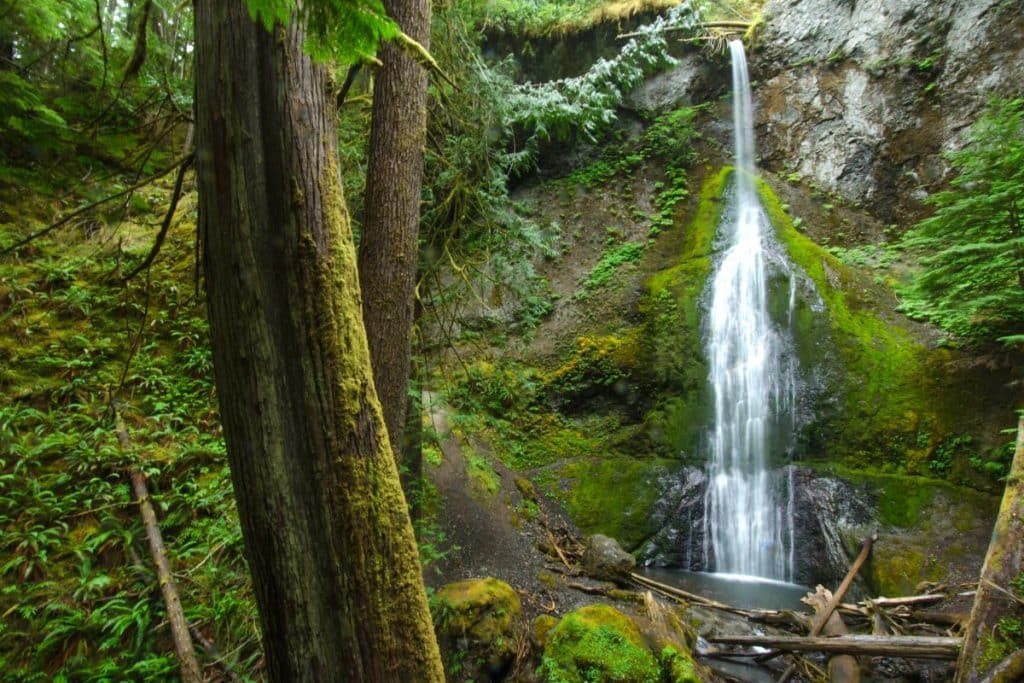
Marymere Falls is the second most famous waterfall in Olympic National Park, behind Sol Duc Falls. However, this waterfall is different!
Instead, Marymere Falls is a high narrow fall that tumbles nearly 100 feet off a cliff covered in greenery.
The trail starts from the Storm King Ranger Station off Highway 101, making it easily accessible for those looking for a quick hike in the Lake Crescent area.
There’s some slight elevation gain to get up to Marymere Falls through a fern-filled forest, but the walk is easy overall.
If you want to extend your hike, consider returning to the Moments in Time Nature Trail and stopping at Lake Crescent Lodge or hiking the strenuous but beautiful trail to Mount Storm King.
6. Mount Storm King
- Distance: 4.1 miles
- Elevation Gain: 2,106 feet
- Difficulty: Hard
- Time to Hike: 4 hours
- Trailhead: Storm King Ranger Station
- Read reviews on AllTrails
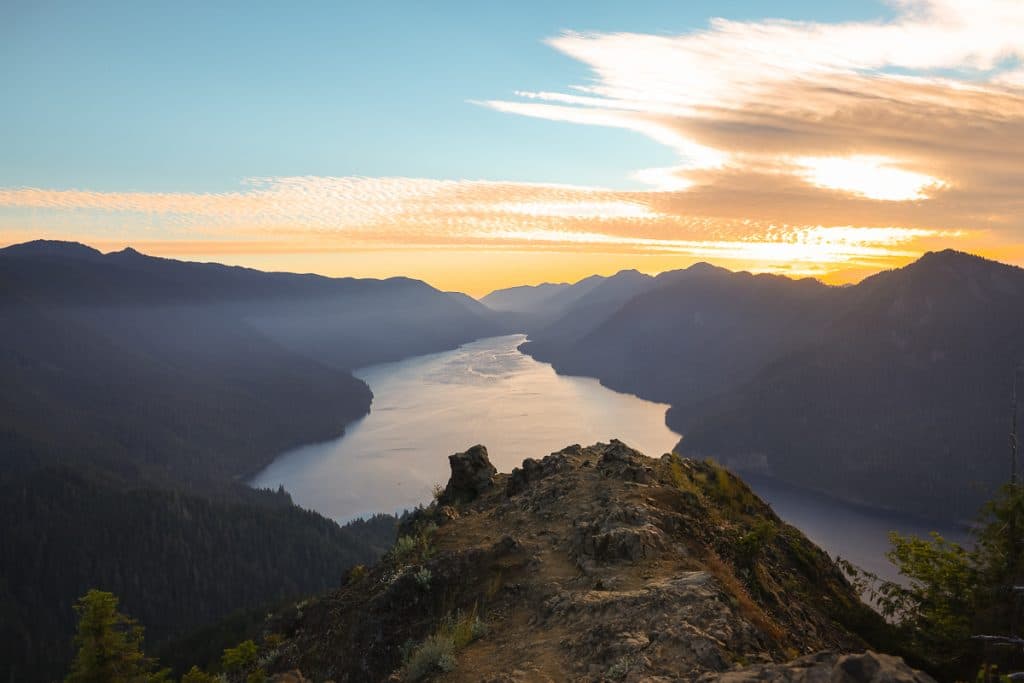
Mount Storm King is one of the most challenging and scariest hikes in Olympic National Park! While the hike is only 4 miles, it climbs more than 2,000 feet of steep switchbacks and features a series of rope scrambles with sharp cliff drop-offs.
But if you’re up for the adventure, the hike provides one of the best views of Lake Crescent and the surrounding mountains and forests!
The trail follows the same initial trail as Marymere Falls but splits off onto forested switchbacks. The switchbacks are incredibly tough, climbing at nearly a 20% grade for 2 miles.
Once you reach the top of the switchbacks, you’ll need to scramble up to the peak on the ropes section.
It’s important to say that the ropes section is dangerous and not maintained by the National Park Service. There are steep 2,000+ foot drop-offs, and it is not suitable for those with a fear of heights.
Only attempt this section if you feel comfortable and have sturdy hiking boots with good traction.
While this hike has incredible views, I wouldn’t attempt it unless you feel comfortable with the ropes section, as you don’t get views of Lake Crescent until you’re at the summit above the tree line.
Read More: Ultimate Guide to Hiking Mount Storm King
7. Lover’s Lane Loop
- Distance: 5.8 miles
- Elevation Gain: 485 feet
- Difficulty: Moderate
- Time to Hike: 2 to 3 hours
- Trailhead: Sol Duc Hot Springs Resort
- Read reviews on AllTrails
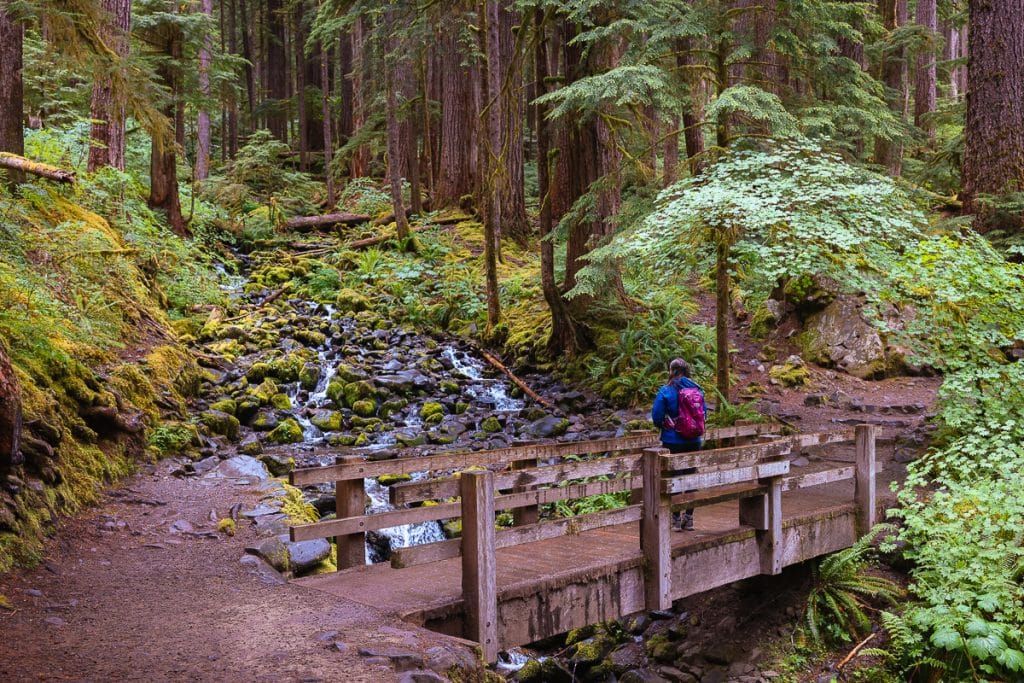
If you love the temperate rainforests in the Sol Duc area, don’t miss the Lover’s Lane Loop! This hike is an extension of the Sol Duc Falls Trail.
Instead of starting at the end of Sol Duc Hot Springs Road, begin at the Sol Duc Hot Springs Resort and follow the Lover’s Lane Trail to Sol Duc Falls. You’ll then return on the B Loop Trail past Sol Duc Campground.
After you’re hike, don’t miss a rejuvenating soak in the Sol Duc Hot Springs at the resort!
8. Devil’s Punchbowl via Spruce Railroad Trail
- Distance: 2.4 miles
- Elevation Gain: 144 feet
- Difficulty: Easy
- Time to Hike: 1 hour
- Trailhead: Spruce Railroad Trailhead off E. Beach Road
- Read reviews on AllTrails
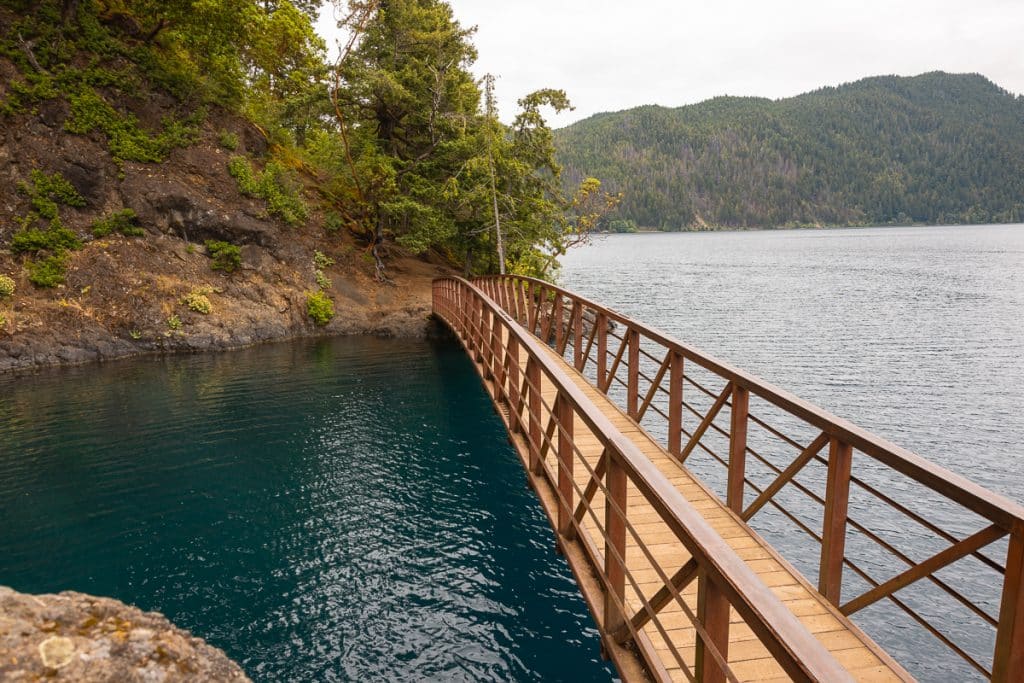
If you want to explore without the crowds on other Lake Crescent trails, don’t miss this short hike to Devil’s Punchbowl!
The hike starts on East Beach Road in a residential area along Lake Crescent. The paved route follows the Spruce Railroad Trail.
This redeveloped railroad path follows the shoreline of Lake Crescent and provides incredible lake and mountain views!
Just over a mile along the trail, you’ll reach a historic tunnel with a pedestrian path that navigates around it to Devil’s Punchbowl. This unique area features incredible teal blue water and a picturesque pedestrian bridge overlooking Lake Crescent.
If you want a break from hiking, the Spruce Railroad Trail continues and is an excellent option for bicycling in Olympic National Park!
Best Pacific Coast Hikes in Olympic
Another iconic area of Olympic National Park is its 60 miles of rugged Pacific Ocean coastline! These coastal hikes feature a mix of beachfront walks and forested routes to ocean viewpoints.
These hikes are breathtaking as sunset as the sun disappears into the Pacific horizon.
9. Hole-in-the-Wall from Rialto Beach
- Distance: 3.3 miles
- Elevation Gain: 108 feet
- Difficulty: Moderate
- Time to Hike: 1 to 2 hours
- Trailhead: Rialto Beach Day Use Parking
- Read reviews on AllTrails

The hike to Hole-in-the-Wall from Rialto Beach is one of the best sunset hikes in Olympic National Park. The walk along the beach rewards you with incredible ocean views and stunning rocky landscapes.
You’ll start at Rialto Beach, a popular day-use area. While the view from here is stunning, the trail becomes even more beautiful as you head down the beach to Hole-in-the-Wall.
This famous rock formation gets its name from its unique appearance as a window through a rock wall. In addition, towering sea stacks and driftwood line the shore.
At sunset, the sky turns a fiery red, casting the surrounding rock formations and sea in a beautiful glow.
The beach is rocky, so it is easiest to hike at low tide on the packed-down sand and smaller rocks. It’s essential to check the tide tables before starting your hike. Parts of the trail are inaccessible at high tide.
10. Shi Shi Beach to the Point of Arches
- Distance: 8.8 miles
- Elevation Gain: 561 feet
- Difficulty: Moderate
- Time to Hike: 4 hours
- Trailhead: Shi Shi Beach Trailhead
- Read reviews on AllTrails
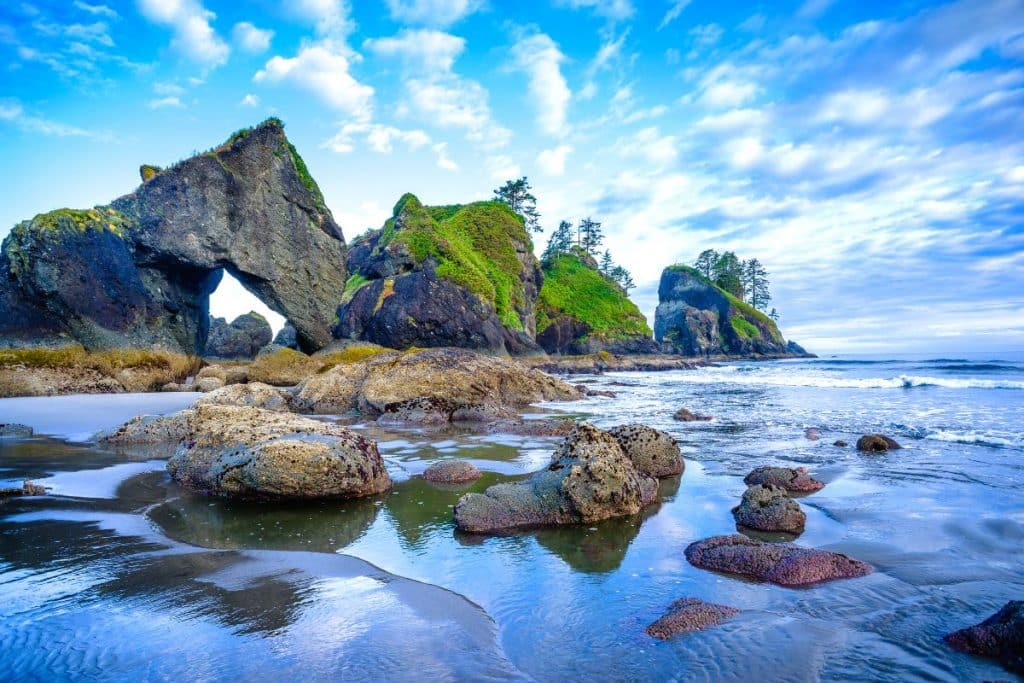
Shi Shi Beach is one of the more remote beaches near Olympic National Park. It’s located on the Makah Indian Reservation in the northwestern part of the Olympic Peninsula.
To hike here, you’ll need to get a permit from the Makah tribe.
The trail follows a jungle path out to the ocean, then takes you further along the sea for a few miles. The shoreline is scattered with rock formations and tide pools, making this a stunning oceanfront hike, especially at sunset!
This hike is often done as a one-night backpacking trip, with hikers camping out on Shi Shi Beach.
11. Ozette Triangle Loop
- Distance: 9.4 miles
- Elevation Gain: 538 feet
- Difficulty: Moderate
- Time to Hike: 4 hours
- Trailhead: Cape Alava Trailhead
- Read reviews on AllTrails
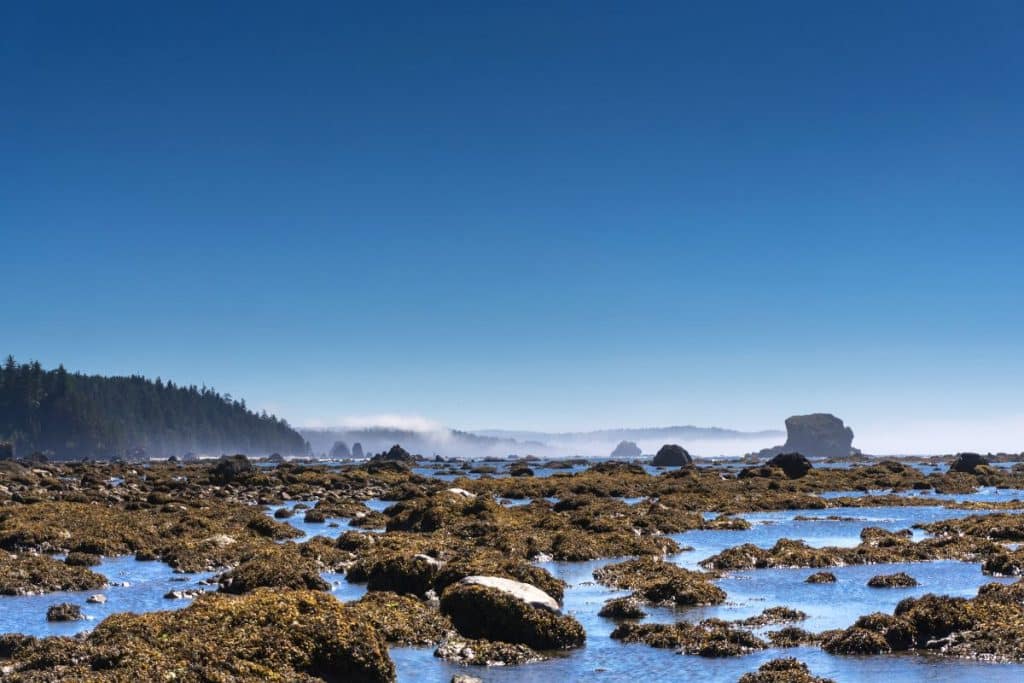
If you’re looking for a long but moderate hike without much elevation gain, don’t miss the Ozette Triangle Loop! This hike starts near the Ozette Ranger Station in the northwest part of the Olympic Peninsula.
The trail forms a triangle hiking through wetlands, forests, and the rugged Pacific Ocean shoreline. With such varied terrains, this hike is an excellent sampler of all that Olympic National Park’s coastal region offers.
You can also make this hike a backpacking trip with several backcountry campgrounds located along the route. However, backcountry camping requires a special permit.
Read More: Camping in Olympic National Park
12. Ruby Beach
- Distance: 1.0 miles
- Elevation Gain: 49 feet
- Difficulty: Easy
- Time to Hike: 30 minutes
- Trailhead: Ruby Beach Parking Area
- Read reviews on AllTrails
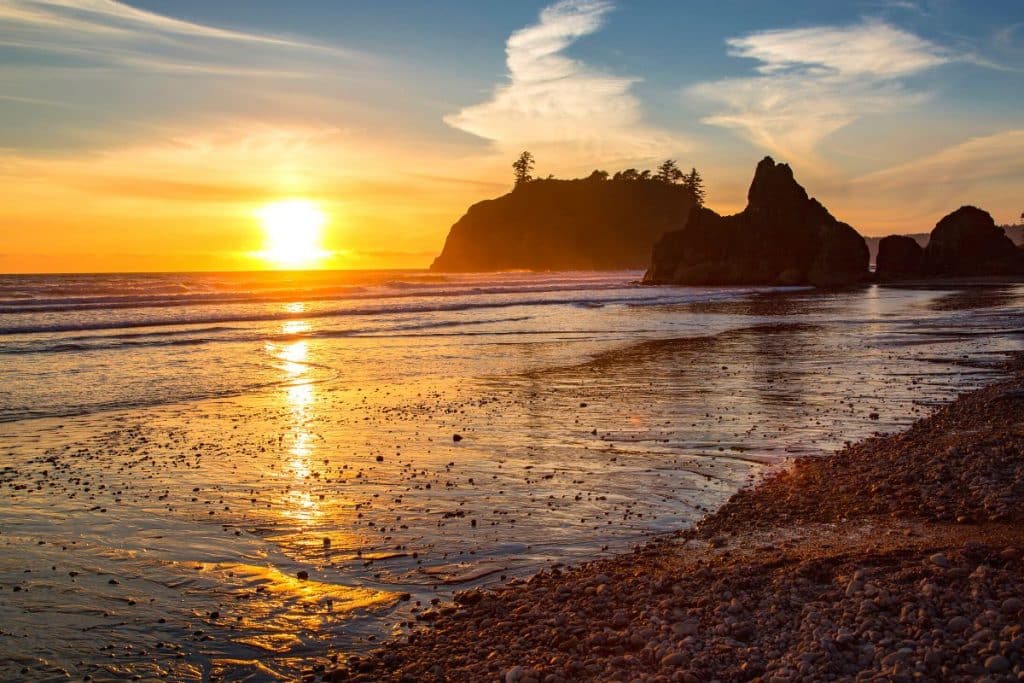
Ruby Beach is one of the most popular coastal destinations in Olympic National Park. The trailhead is located off Highway 101, making it a convenient and quick stop on your Olympic itinerary.
The trail is only a mile round trip and mostly flat. Ruby Beach is the perfect hike for those looking for something more manageable and family or senior-friendly.
You’ll follow a paved trail from the parking lot to a viewpoint of Ruby Beach, followed by a path onto the beach. The shore is filled with sea stacks and driftwood, making it a fun place to pause and explore the coastal landscape.
Ruby Beach is also one of the most popular places in Olympic National Park to see the sunset!
13. Second Beach Trail
- Distance: 2.1 miles
- Elevation Gain: 278 feet
- Difficulty: Easy
- Time to Hike: 1 hour
- Trailhead: Second Beach Parking Area
- Read reviews on AllTrails
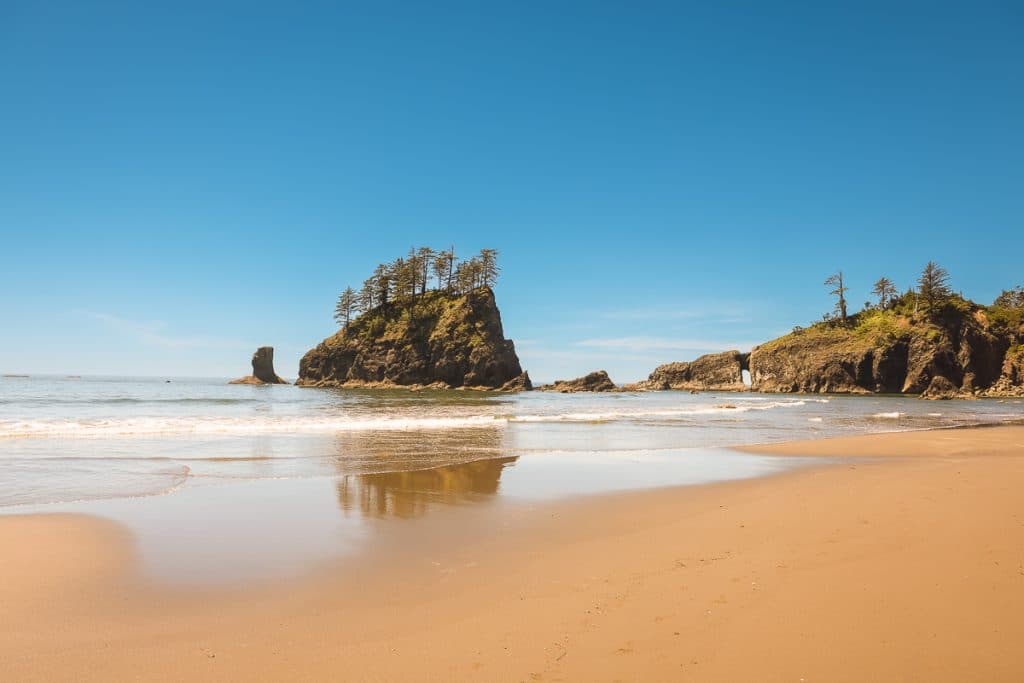
Second Beach is one of the three La Push beaches on and near the Quileute Reservation. First Beach is simply an overlook point, while Second and Third Beach offer hikes through wooded areas out to the beach.
The Third Beach hike is a bit longer and more challenging, so Second Beach Trail is the best option for those looking for a more leisurely day hike. The trail starts in a parking area on the Quileute Reservation.
Next, you’ll follow a path through a heavily wooded area. After about a mile, you’ll catch your first views of the ocean.
You’ll climb down stairs built into the hillside (it’s a pretty steep climb, so only go down if you can make it back up!). Once on the beach, you’re greeted with towering rock formations jutting out of the icy waters of the Pacific Ocean.
Second Beach is one of the best beaches in Olympic National Park. Many visitors opt to bring a cooler and towel and spend the day relaxing on the picturesque beach.
Best Hikes in Hoh & Quinault Rainforests
The temperate rain forests are Olympic National Park’s most famous landscapes. The delicate landscapes are home to hundreds of years old trees and can only be found on the US west coast, Chile, New Zealand, and Australia.
Hoh Rain Forest is the most visited temperate rainforest in Olympic, while Quinault Rain Forest provides similar landscapes but with fewer great trails and crowds.
On these hikes, you’ll find dense woods covered in ferns and mosses.
14. Hall of Mosses Trail
- Distance: 1.1 miles
- Elevation Gain: 78 feet
- Difficulty: Easy
- Time to Hike: 30 minutes
- Trailhead: Hoh Rain Forest Visitor Center
- Read reviews on AllTrails
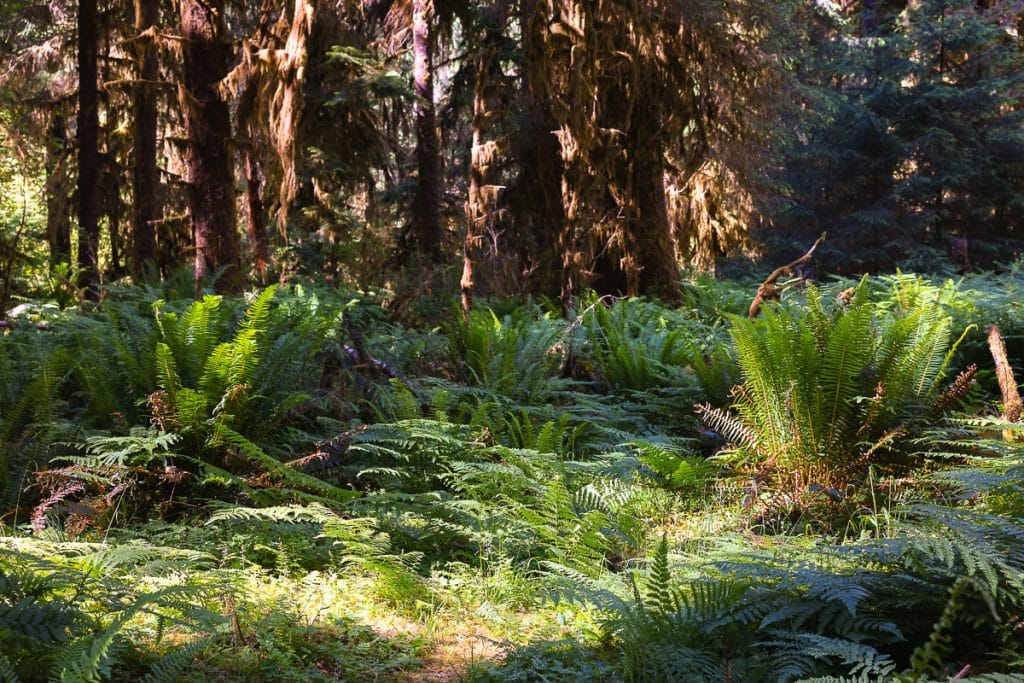
The most popular rainforest hike is the Hall of Mosses Trail. It guides you through the Hoh Rain Forest and is a great place to see moss-covered trees and learn about the fragile temperate rainforest environment.
The Hall of Mosses Trail starts at the Hoh Rain Forest Visitor Center and guides you through the forest on a well-maintained 1-mile path. Throughout the hike, you’ll find signs to learn more about the ecosystem.
Given the popularity of this hike, the parking lot often fills by 9 AM in the summer. To avoid crowds and summer humidity, plan to arrive at Hoh Rain Forest before 8 AM.
Early morning is also the most photogenic time in the rain forest, with soft sun rays filtered through the dense tree canopy.
15. Spruce Nature Trail
- Distance: 1.4 miles
- Elevation Gain: 16 feet
- Difficulty: Easy
- Time to Hike: 30 minutes
- Trailhead: Hoh Rain Forest Visitor Center
- Read reviews on AllTrails
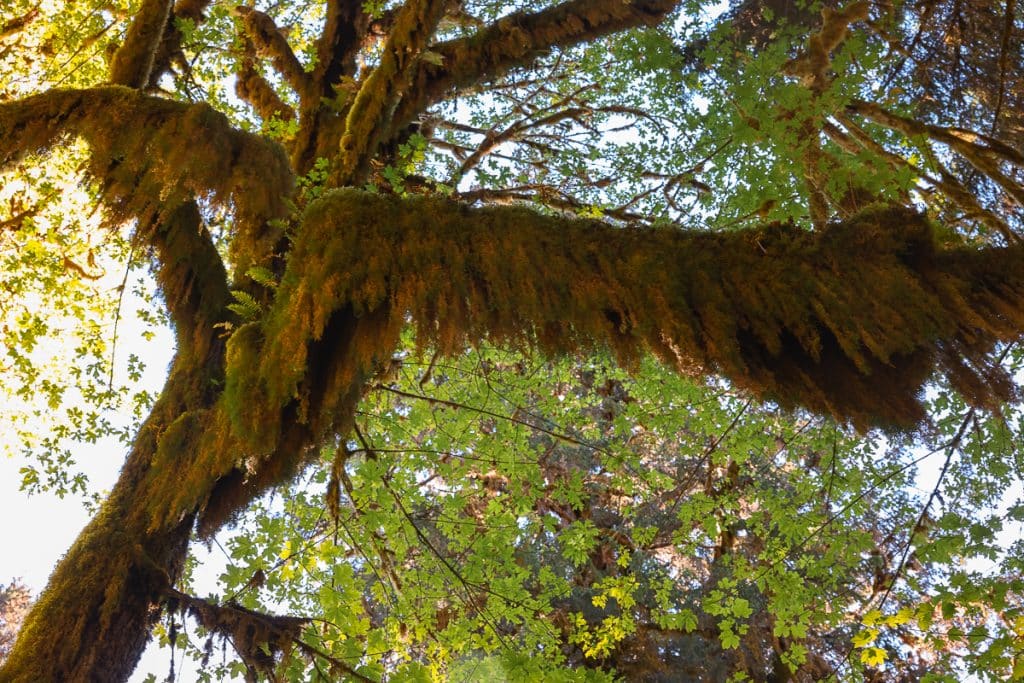
The Spruce Nature Trail is a popular trail addition for those doing the Hall of Mosses Trail.
These two hikes can be completed as a loop and provide an excellent comparison between the younger Spruce Nature Trail and the older Hall of Mosses rain forest.
You’ll start at the Hoh Rain Forest Visitor Center and follow the trail through the younger part of the forest that takes you out along the Hoh River.
This hike tends to be less crowded than Hall of Mosses but shares the same parking lot, so you’ll still need to arrive before 9 AM to secure a parking spot in the summer months.
16. Hoh River Trail to Five Mile Island
- Distance: 10.1 miles
- Elevation Gain: 387 feet
- Difficulty: Moderate
- Time to Hike: 4 hours
- Trailhead: Hoh Rain Forest Visitor Center
- Read reviews on AllTrails
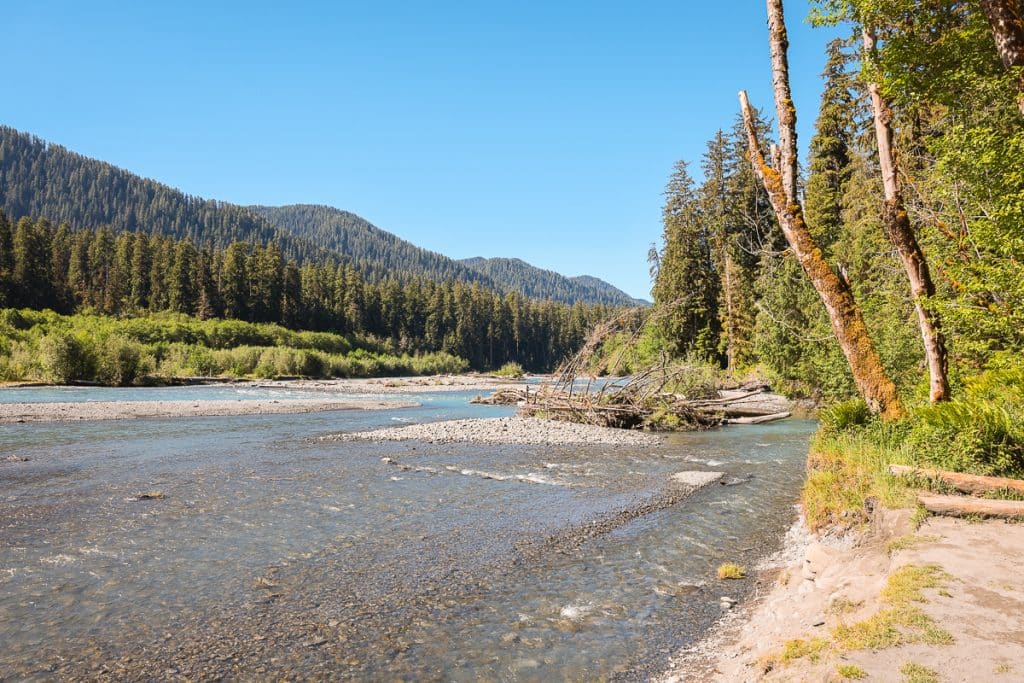
Don’t miss the Hoh River Trail if you’re looking for a less crowded trail in the Hoh Rain Forest area. The distance makes this a less popular choice for many hikers. However, the trail is primarily flat with a gradual elevation grade.
The trail starts from the same parking lot as the Hall of Mosses Trail and follows the Hoh River Trail out to Five Mile Island, a popular spot for picnics and backcountry camping.
The route provides plenty of opportunities to see brightly colored moss, wildlife, and the Olympic Mountain Range.
Since this hike is out-and-back, you can also turn around whenever you’d like, making it a more family-friendly walk.
The best time to hike this trail is in the summer when the ground is drier, and there’s less rain. Otherwise, the Hoh River Trail may be very muddy.
17. Quinault Loop Trail
- Distance: 0.9 miles
- Elevation Gain: 111 feet
- Difficulty: Easy
- Time to Hike: 30 minutes
- Trailhead: Quinault Rain Forest Trailhead Parking
- Read reviews on AllTrails
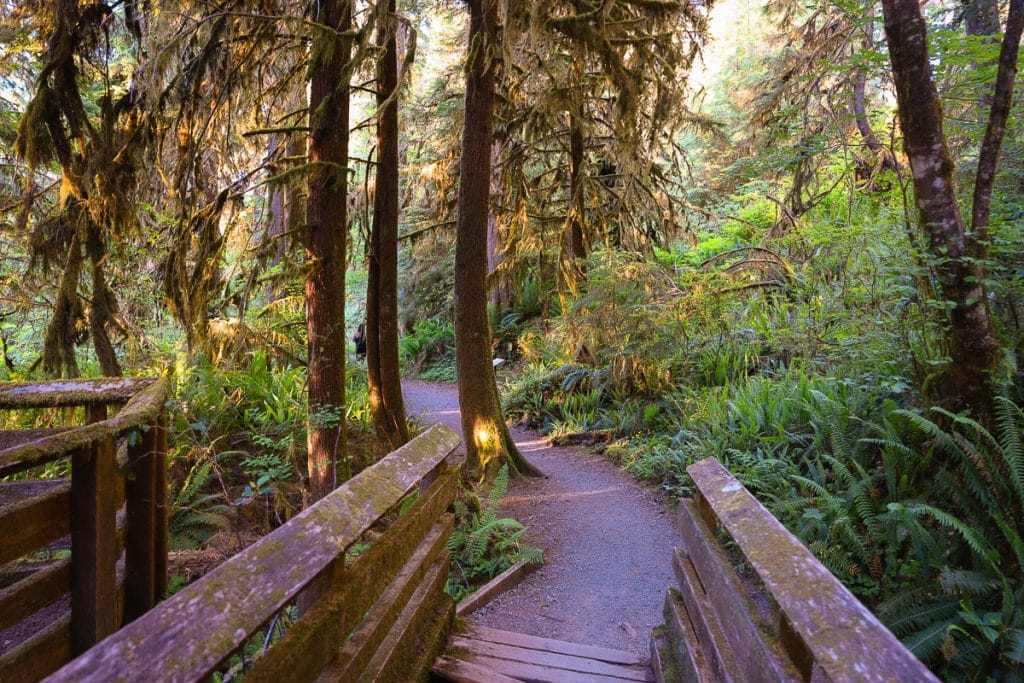
The Quinault Loop Trail is one of the best hikes in the Quinault Rain Forest, located in the southwestern part of the Olympic Peninsula. Compared to the Hoh Rain Forest, this hike is much less crowded.
The trail takes you through the old-growth Quinault Rain Forest, with educational signs teaching you about the lush mosses, ferns, and wildlife found here.
After the short hike through the Quinault Loop, head to Lake Quinault Lodge for beautiful views of Lake Quinault, especially at sunset and golden hour!
Best Hikes in the Olympic Staircase Region
The Staircase region is the least visited part of Olympic National Park, located on the southeastern side of the Olympic Peninsula. This mountainous region feels different from other parts of the park. It’s water-filled, less crowded, and peaceful.
These hikes rarely have crowds and offer an opportunity to escape into the Olympic wilderness. However, you’ll need to drive the maintained gravel road out through the Olympic National Forest to get here.
18. Staircase Rapids Loop
- Distance: 2.1 miles
- Elevation Gain: 213 feet
- Difficulty: Easy
- Time to Hike: 1 hour
- Trailhead: Staircase Ranger Station
- Read reviews on AllTrails
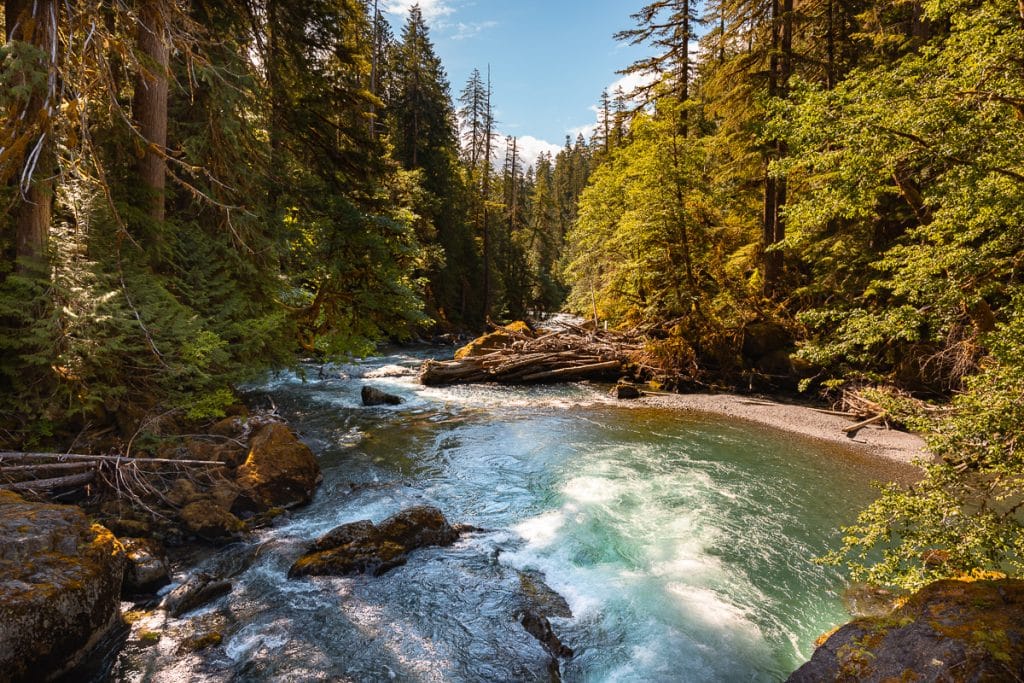
The Staircase Rapids Loop is the perfect sampler of all the Staircase region offers. There are waterfalls, cascading rivers, lush old-growth forests, and mountain views.
Plus, you can learn more about the area, including how it got its name, through interpretive signs found along the trail.
The hike starts near the ranger station and follows the Skokomish River through an old section of temperate rainforest.
One of the hike’s highlights is the recently replaced suspension bridge over the river, a beautiful piece of engineering in this serene landscape.
19. Mount Ellinor Trail
- Distance: 5.9 miles
- Elevation Gain: 3,392 feet
- Difficulty: Hard
- Time to Hike: 6 hours
- Trailhead: Mount Ellinor Lower Trailhead
- Read reviews on AllTrails
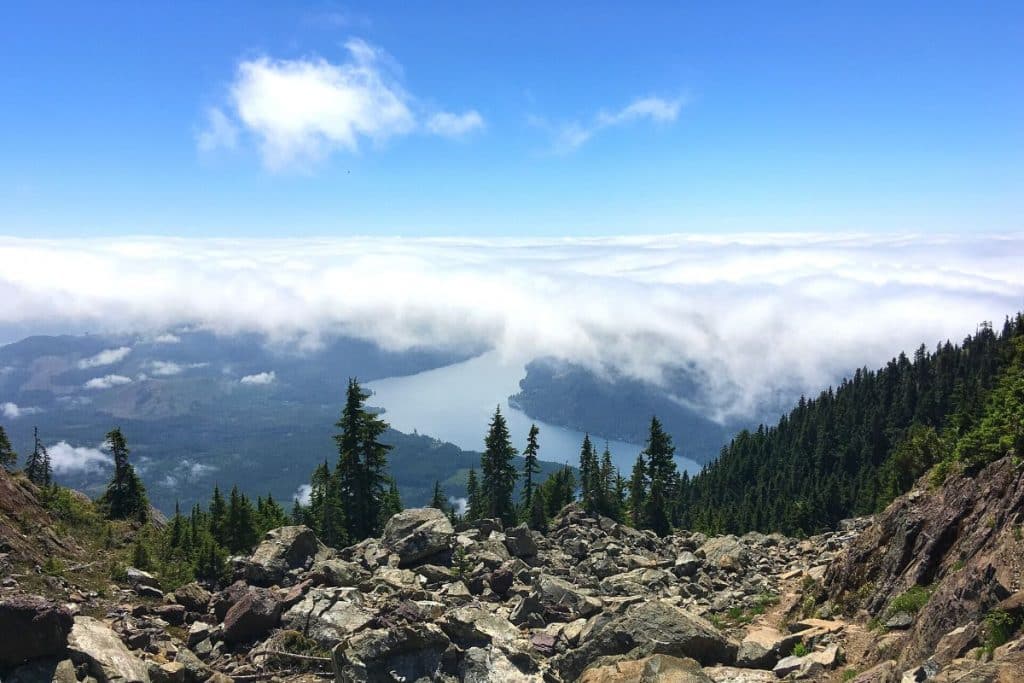
If you’re looking for a more challenging hike in the Staircase area, don’t miss the Mount Ellinor Trail! This hike packs in the elevation gain and takes you to the top of one of the tallest regions in this part of the Olympic Peninsula.
On a clear day, you can see Mount Rainier and Mount Baker to the east!
While there’s a steeper, more direct route to Mount Ellinor’s top, the “Lower Trail” is the best route. This route follows the switchback trail through the forest and provides beautiful views of the Olympic Mountains the entire way.
Best Backpacking Trails in Olympic National Park
If you want to escape the crowds in Olympic National Park, you should spend some time in the backcountry.
There are several backpacking routes through the Olympic Wilderness, but these two hikes listed below are the most popular and belong on your bucket list.
Backcountry camping requires a wilderness permit and all hikers should be well-versed in bear safety and carry bear canisters for food storage.
20. High Divide and Seven Lakes Basin Loop
- Distance: 19.0 miles
- Elevation Gain: 5,308 feet
- Difficulty: Hard
- Time to Hike: 2 to 4 Days
- Trailhead: Sol Duc Trailhead
- Read reviews on AllTrails
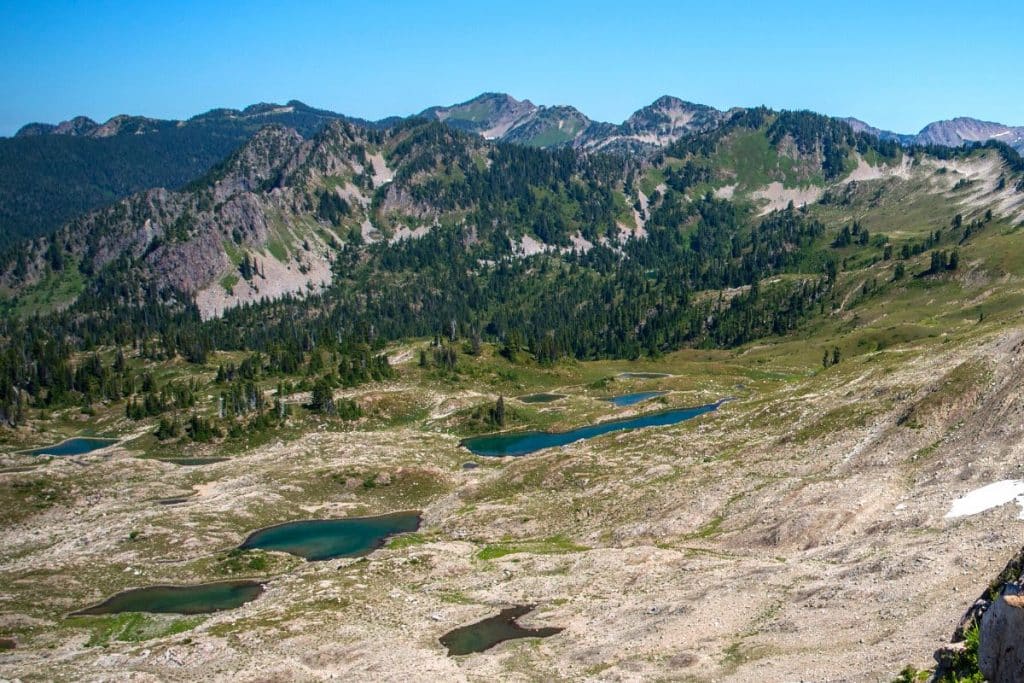
The High Divide and Seven Lakes Basin Loop is one of the premier subalpine hikes in Washington.
The stunning Pacific Northwest trail displays beautiful rainforest and alpine landscapes in a 19-mile hike best done over several days.
You’ll start at Sol Duc Falls before continuing along the High Divide Trail into the Seven Lakes Basin, named for the seven lakes found here.
The trail takes you through the Olympics and to the summit of Bogachiel Peak, providing views of Mount Olympus and Blue Glacier on a clear day.
This trail provides unparalleled opportunities to spot wildlife like black bears, elk, and mountain goats.
21. Enchanted Valley Chalet via East Fork Quinault River Trail
- Distance: 27.0 miles
- Elevation Gain: 3,244 feet
- Difficulty: Hard
- Time to Hike: 2 to 4 Days
- Trailhead: Graves Creek Trailhead
- Read reviews on AllTrails

The Enchanted Valley is another epic multi-day hike through Olympic National Park’s wilderness. The trail guides you through old-growth forests to a wide valley and the historic Enchanted Valley Chalet.
The trail starts at the dead end near Graves Creek Campground, past the Quinault Ranger Station.
The stunning hike reaches the final incredible view of the chalet with the Olympics towering above it. Waterfalls cascade down the mountains in the summer, making this view genuinely picturesque.
Since you hike out and back, some follow the route only as far as Pony Bridge before turning around to make it a day hike. This trail also provides an excellent chance to see bears, elk, deer, and mountain lions.
Final Thoughts on the Best Olympic National Park Hikes
There’s no shortage of incredible hikes in Olympic National Park, from beachfront strolls to treks through dense forests and alpine landscapes.
If you’re looking for the best things to do, don’t miss these nine incredible Olympic National Park hikes:
- Hurricane Hill Trail
- Sol Duc Falls Nature Trail
- Marymere Falls Trail
- Mount Storm King Trail
- Hole-in-the-Wall from Rialto Beach
- Ruby Beach Trail
- Second Beach Trail
- Hall of Mosses Trail
- Spruce Nature Trail
Don’t miss these posts if you’re looking for more Olympic National Park inspiration!
- Top Rated: 27 Best Things to Do in Olympic
- Mt Storm King: Ultimate Guide to Hiking Mount Storm King
- Where to Stay: 55 Best Places to Stay Near Olympic
- Camping: 15 Best Campgrounds in Olympic
- Washington: 3 Best National Parks in Washington
Are you planning a national park trip but don’t know where to start? Get my free 28-page national park ebook where I break down everything you need to know to visit all 63 USA national parks.
Download your free ebook here.
Don’t Forget to Save This Post on Pinterest
